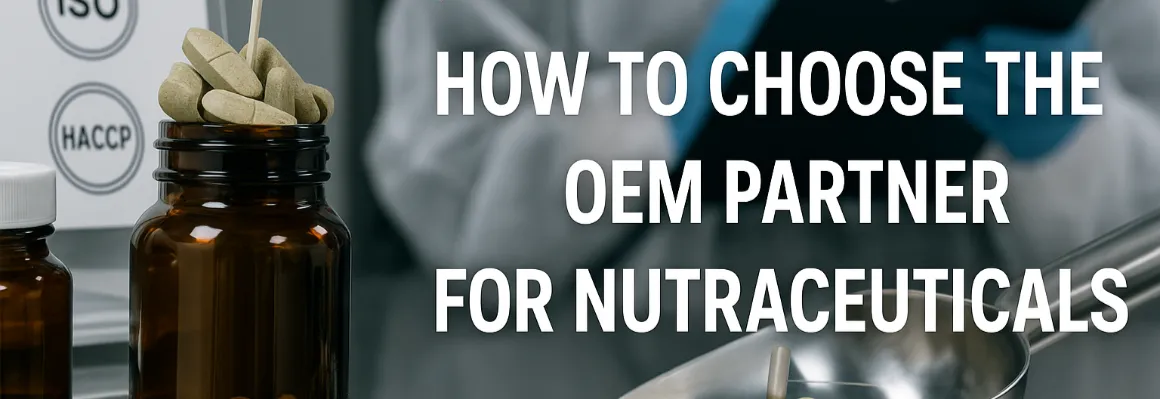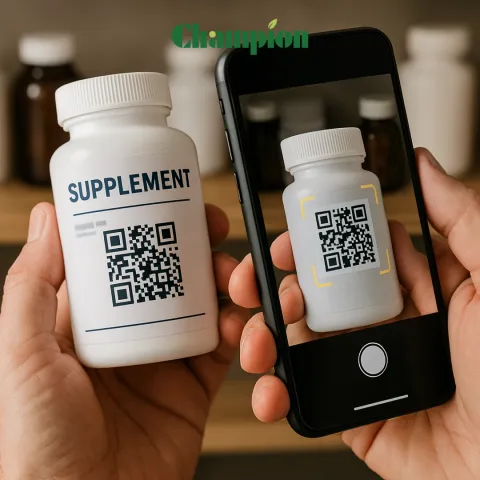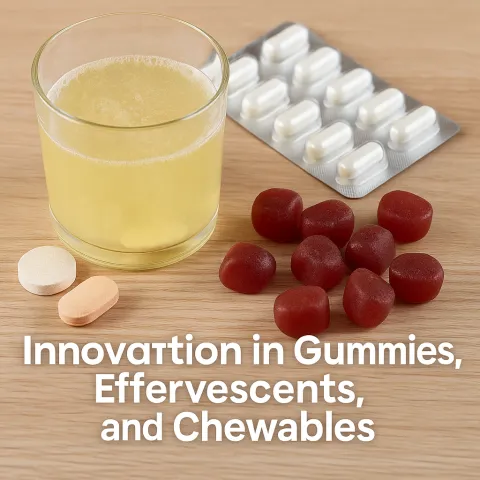Blog
04.Sep.2025
How to Choose the Right OEM Partner for Nutraceuticals

Introduction
For nutraceutical brands, selecting the right OEM (Original Equipment Manufacturer) partner is a make-or-break business decision. The OEM directly impacts product quality, compliance, speed-to-market, and brand reputation. As supplement competition intensifies, knowing the right decision criteria and how to spot red flags is crucial for long-term success. This guide covers everything—expert selection tips, key certifications, best practices, and risks to avoid for growing your private label nutraceutical brand.Why OEM Partner Selection Matters
- The global health food market is expected to exceed $230 billion in 2025, with OEM-driven brands capturing the lion’s share of new launches and innovation.
- Top nutraceutical brands report that quality and compliance failures from an OEM partner can result in six-figure losses and lasting reputational damage.
- An experienced OEM can help you differentiate, scale rapidly, control costs, and deliver unique formulas to market faster—while minimizing legal, supply chain, and safety risks.
Key Criteria for Selecting Your Nutraceutical OEM Partner
1. Regulatory Compliance and Certifications
- Verify GMP (Good Manufacturing Practice), ISO, HACCP, FDA, EU, and other relevant international certifications as a baseline.
- Request recent audit reports and ask for documented compliance on critical aspects: ingredient testing, batch records, and recall protocols.
- Compliance is non-negotiable: failure here can lead to recalls, import bans, and reputational harm.
2. Custom Formulation and Innovation
- Leading OEMs offer tailored formulations (vegan collagen, probiotics, enzymes) and robust R&D capability.
- Unique products win in crowded markets; avoid white-label traps with generic formulas reused across brands.
- Assess their portfolio for evidence of ingredient expertise, trending bioactives, and focus on product differentiation.
3. Manufacturing Scalability and Flexibility
- Your OEM should support growth—offering flexible MOQs (minimum order quantities), fast scale-up potential, and reliable supply chain management.
- Ask about current capacity, expansion plans, and how they handle demand surges or seasonal peaks.
- Modern manufacturing technologies streamline quality control and efficiency; avoid partners lagging in innovation.
4. Quality Control and Sourcing Transparency
- Demand documentation for raw material sourcing, full traceability, and real-time quality assurance systems.
- Insist on batch testing, stability assurance, and ingredient certificates of analysis (COAs).
- Audits of supplier networks and safety processes, preferably third-party, reduce risk and boost trust.
5. Communication, Collaboration, and Customer Service
- Effective OEMs provide a dedicated project manager or main point of contact.
- Expect regular progress updates, transparent feedback loops, and industry/customer knowledge.
- Responsive customer support is essential for issue resolution, product iteration, and long-term partnership.
Insider Interview: Advice From a Supplement Brand Leader
“Switching OEM partners transformed our business. The right choice gave us faster development timelines, specialist ingredient access, and peace of mind for compliance. Open communication and proven certifications were our deal-breakers.”— Jane Peterson, Director, Growing Nutraceutical StartupRed Flags When Vetting Nutraceutical OEMs
Don’t ignore these warning signs—they can save your business time, money, and reputation:- Limited or outdated production capacity (may signal inability to meet demand).
- Inadequate technology, innovation, or lax QA systems (leads to inconsistent products and slower launches).
- Lack of transparency about quality controls, certifications, or sourcing.
- White-label traps—reusing generic products under multiple brands, harming differentiation.
- No willingness to share regular updates or allow client audits.
- Poor communication, slow response times, or missing documentation.
- Minimums or lead times that don’t align with your scaling goals.
Top 7 Questions to Ask Your OEM Partner
- How transparent is your manufacturing process? (Ask for site visits, virtual tours, detailed process documentation).
- What certifications and compliance standards do you follow? (GMP, ISO, FDA, NSF, region-specific).
- Can you provide full documentation and traceability? (Batch records, COAs, ingredient origins).
- How do you support custom formulations and sourcing? (Innovation, supplier networks, compliance assurance).
- What are your MOQs and lead times? (Clear guidelines help plan cash flow and launches).
- What kind of post-sale support and partnership can I expect? (Policy details, product improvement, staff training).champion-bio
- How do you manage product testing and quality assurance? (QA/QC process, frequency, escalation protocol).champion-bio
Final OEM Partner Checklist
| Criteria | Verified/Notes |
| Manufacturing transparency |
|
| Compliance docs/certifications |
|
| Product traceability |
|
| Custom formulation capability |
|
| MOQs/lead times |
|
| Customer support |
|
| QA/QC protocols |
Best Practices for a Winning OEM Relationship
- Implement clear contracts with detailed timelines and quality metrics—reduce misunderstandings.
- Set performance metrics and review regularly—track quality, delivery times, cost efficiency, and areas for improvement.
- Schedule regular audits and site visits—verify adherence to standards, encourage accountability, and uncover issues proactively.
- Maintain information flow and transparency—digital communication ensures responsiveness and agility in problem-solving.
- Encourage innovation—OEM partners at the forefront of new ingredients/formulations give your brand a competitive edge.
Conclusion: Building Long-Term Success With the Right OEM Partner
OEM partner selection in nutraceuticals decides your brand’s reputation, speed, and scalability. Prioritize partners who combine transparent compliance, custom formulation, capacity for growth, and proactive communication. Use detailed checklists, interviews, and best practices to safeguard your business, avoid costly mistakes, and set your brand up for lasting success.Ready to select your OEM partner?
Download a full OEM partner checklist and connect with Champion Bio or other proven leaders to bring your vision to life with safety, speed, and market-winning innovation.



















